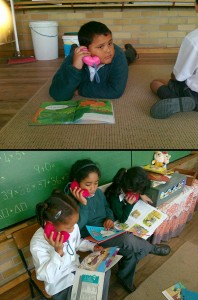 Introduce learners to the concept of metacognition by asking them to think about how they go about making meaning from what they read. Lead them to discover that good readers are good thinkers, and that while they read they need to be aware of how ‘the voice inside their heads’ needs to dialogue with the words on the page. Good readers think along with the text, they interact with the ideas expressed on the page. The use their THINKING POWERS.
Introduce learners to the concept of metacognition by asking them to think about how they go about making meaning from what they read. Lead them to discover that good readers are good thinkers, and that while they read they need to be aware of how ‘the voice inside their heads’ needs to dialogue with the words on the page. Good readers think along with the text, they interact with the ideas expressed on the page. The use their THINKING POWERS.
Good readers
- Make connections and their thoughts sound like: “This part of the story or this character reminds me of . . . .
- Pose questions that sound like “I wonder if . . .” I wonder why . . . ,” “What if . . .”
- Visualise and their thoughts sound like: “These picture words put images in my mind. I can see in my mind’s eye . . . I can hear . . . I can taste . . ., touch . . . what the author is describing.”
- Infer and their thoughts sound like “I think that . . .” “Maybe . . . .” which can be predictions of what they imagine will happen, and inferences based on information they have gained from the text and putting it together with what they know about the world,
- Transform their thinking, which sounds like “I now understand that . . .” “I noticed that my thinking changed while I was reading. At first I thought . . ., and then I thought . . .” “After reading this I now know, feel, think, want to . . . .”
Have learners use the Sebezaphone to assist them in listening to and hearing their internal voice. Encourage them to use the starter sentences to prompt their thinking for each of the Thinking Powers. Ask them to note how the thinking power enabled them to better understand and make personal meaning from what they are reading and learning.
- Think-Alouds. Have learners dramatise the dialogue that their thinking voices have with the author’s words by changing the hand that holds the Sebezaphone. For example, when they are reading aloud the author’s words, they hold the phone with their right hand to their right ear. After a paragraph or two, they can then change hands so that their left hand holds the phone to their left ear. Now their task is to think aloud in a whisper, into their phone. When they feel complete, they change hands again, and continue to read aloud the author’s words, hold the phone to their right ear.
For more information about Thinking Powers and how to teach metacognition, visit www.metagroup.co.za to view a video clip from the Professional Training DVD Thinking Powers for Reading Comprehension: How to integrate reading into learning area teaching and find out how to purchase it with an Educator’s Guide.

